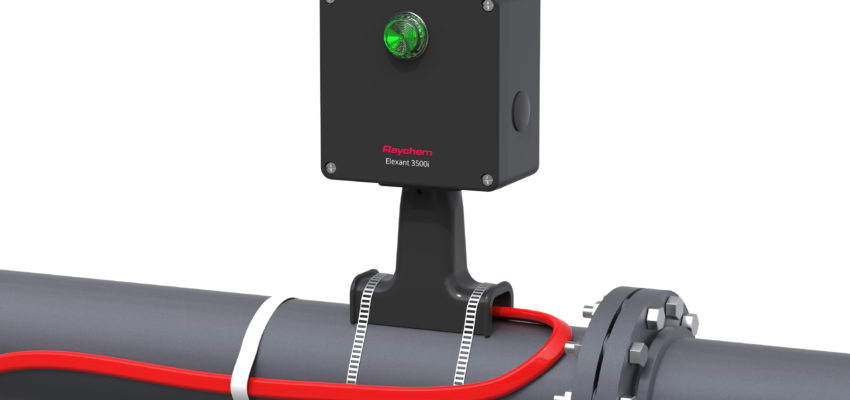Chemelex recently introduced its new line of Raychem Elexant 3500i electronic thermostats to the industrial heat tracing market for control and monitoring in North America. The Elexant 3500i is a family of electronic thermostats that bridges the market gap between basic thermostats and more advanced controllers.
Why upgrade to an Elexant 3500i electronic thermostat? In order to answer this question, we first need to understand what is currently being used to control industrial heat tracing. Does your facility have pipe freeze protection in place?
Designed from a common hardware platform (an interchangeable electronics module), the Elexant 3500i offers five variants and two enclosure types to allow customers the flexibility to tailor the product to their heat tracing needs.
No Control
If your facility currently has no control for the heat tracing you have installed, you may be struggling with high energy consumption because of inefficient power use. You may want to introduce a basic thermostat to help improve your energy efficiency, give you basic temperature control capabilities for the self-regulating cable you are using. With the Standard 3500i variant, you do have a local indicator light, one temperature sensor, quick connect terminals and a modular design that comes with all 3500i products. The modular design gives you the ability to upgrade your thermostat for when your facility does have greater control and monitoring needs, you can easily switch out your Standard for a different variant at any time.
Mechanical Only
If you do currently have some control but are using basic temperature control, you will not have the ability to supervise, in other words, you have no alarming or monitoring capabilities. You may want to introduce the Alarm 3500i variant, this variant is more reliable and accurate than a mechanical thermostat. There is also a lower total installed cost as the 3500i family of products eliminates the cost of external junction boxes. The Alarm variant provides all the features of the Standard variant but also includes alarm relay. An alarm relay enables a customer to connect to get a common alarm indication. A customer can daisy chain multiple products using this alarm relay to receive alarm indication for multiple circuits. An alarm relay alerts plant operators to potential problems thus preventing equipment damage and ensuring safer operations. Although the alarm relay will not provide details on what the alarm is for, it will provide basic status indications. Compared to mechanical thermostats, the more advanced variants like the Communicating, Current Sensing and Ground Fault Detecting versions allow for remote monitoring and have much greater reliability compared to very simple temperature control.
Electronic – But Connected
Already using electronic thermostats to control your heat tracing? That’s great. Are these devices optimized for easy communication? The Communicating 3500i variant uses RS-485 and Bluetooth connectivity which provides visibility for the health of the thermostat and sensor, this is something that does not come with the Standard and Alarm 3500i variants. Why is this useful?
As mentioned previously, the Alarm variant provides some basic status indication of an alarm but it does not give any detail about the alarm. RS-485 and Bluetooth communication will give the user much greater information on the alarm. Communications over RS-485 can not only tell plant operators there is an alarm but will provide the type of alarm, what circuit the alarm is on, when the alarm was triggered and what the value of the alarm is. For example, the Communicating variants of the 3500i will tell plant operators there is a low temperature alarm on circuit X when the temperature sensor measured 8°C and this occurred 15 minutes ago, the heat tracing has since then kicked in, and there is currently no alarm. In addition to this benefit, the Communicating variants are configurable as a thermostat or a high temperature limiter. The Communicating variants of the 3500i when configured as high temperature limiters do have the ability to act like a backup device to turn circuits off in scenarios where the controller fails to do so, thus aiding in adding redundancy to prevent fires and other damage in hazardous environments.
Electronic – But Connected and Monitoring
Already using electronic thermostats with communications built in? What about a function such as an automated test every 24 hours? The Current Sensing and Ground-Fault Detecting 3500i variants do just that and they come with two temperature sensors. The Current Sensing 3500i variant has the ability to alarm based on low current, as low as 0.1A. In cases where a very short circuit such as the drain on a tank is installed, circuits can easily be in a state of alarm but by sensing a truly low current as low as 0.1A, these types of nuisance alarms can be avoided. This is compared to other thermostats on the market where the low current alarm threshold is only 0.3A. The Ground Fault Detecting 3500i variant is built with ground fault protection in mind. The auto-test eliminates the need for manual checks saving on maintenance costs each year, both of these variants are able to monitor temperatures for multiple flow paths with dual RTD support as well. This means if you have more than one flow path that you are heat tracing, the Current Sensing and Ground Fault Detecting variants will be able to monitor temperatures on both mitigating the risk of missing a flow path that may be freezing.
Note: The Ground Fault Detecting variant of the 3500i is only available in North America.
If your needs exceed that of an electronic thermostat with both communications and monitoring capabilities like ground fault detection and current sensing, then your needs may warrant a controller. If you are interested in an integrated touch screen, advanced power control and management, advanced temperature control algorithms, more connectivity options like Ethernet and the ability to lower retrofit costs by integrating with existing temperature sensors using 4-20mA inputs, then a Raychem Elexant 4010i would better meet your needs.
In summary, there are compelling reasons to upgrade to a 3500i electronic thermostat:
- There is a lower Total Installed Cost (TIC) compared to mechanical thermostats
- Users can further save costs on future upgrades as the electronics modules of the Elexant 3500i are interchangeable
- Installation is fast and easy
- Local Indicator Light is front and center on the 3500i enclosure and not hidden out of site giving users clear indication of any current alarms
- Easily configurable via Bluetooth
- Easily daisy-chain and mid feed in the power connection kit
And lastly, the Elexant 3500i is a more reliable thermostat than a mechanical thermostat; it has hybrid switching relay (SSR + EMR) rated to 250,000 power cycles for superior product life (IEC 60079). End users do not need to replace their thermostat as frequently as they would if it were a mechanical thermostat (which is typically rated for 100,000 power cycles). The 3500i is built to have a much longer product life which ultimately lowers a user’s total operating cost.
To learn more about the Elexant 3500i product family, visit the product page here.


